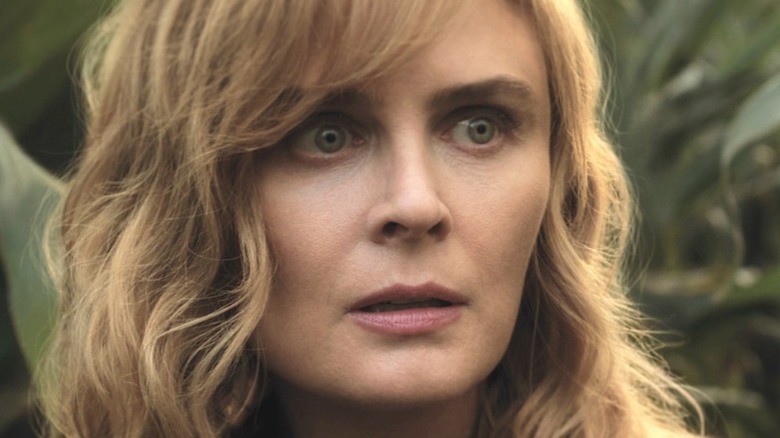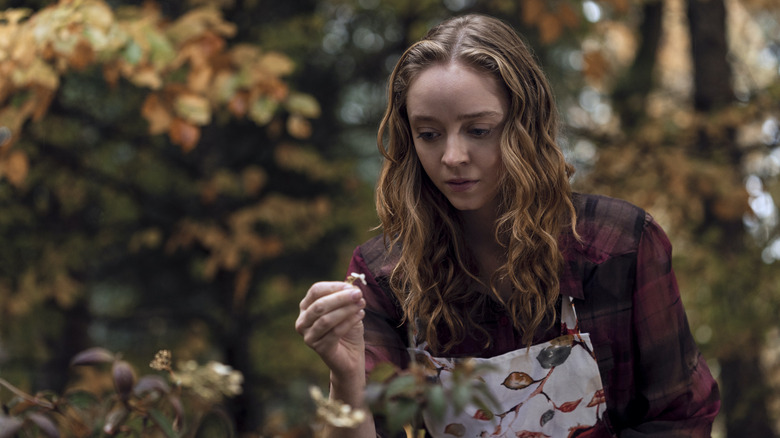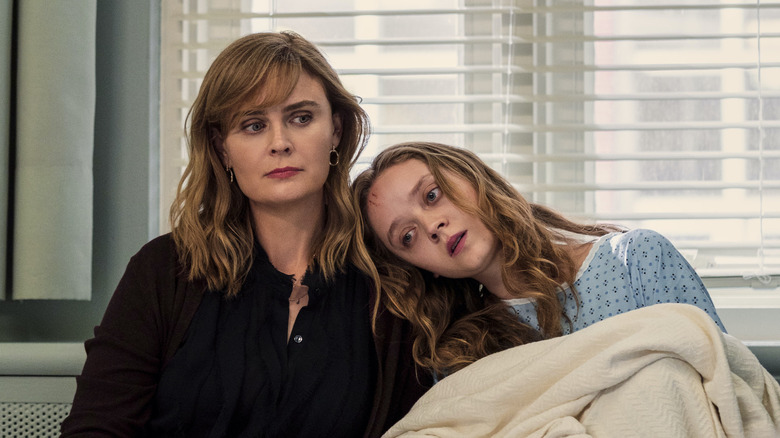Devil In Ohio's Emily Deschanel And Madeleine Arthur Explore Their Dynamic In The Netflix Thriller - Exclusive Interview
When a teenager shows up at a local hospital with a symbol carved into her back in Netflix's new thriller "Devil in Ohio," psychiatrist Suzanne Mathis immediately takes pity on her. She soon learns that the girl's name is Mae, and she's escaped from a strange cult that's managed to hide in plain sight in a neighboring county for decades. Mae's troubled upbringing makes her a question mark, yet Suzanne quickly decides to take her in, bringing her home to her family, including her three daughters. While Suzanne sees a kindred spirit in Mae, the girl's arrival leads to a series of events that tear at the seams of Suzanne's previously stable family life.
Suzanne and Mae are played by Emily Deschanel and Madeleine Arthur, respectively, and both actors turn in nuanced performances that get to the heart of the psychological trauma that drives these characters. Deschanel, who is known for portraying the lead character on "Bones" for twelve seasons, is caring and sympathetic as Suzanne, but Mae's entry into her life also brings up issues from her past that seem to blind her to the impact the teen is having on her family. Meanwhile, Arthur, whose credits include "The Magicians," "Snowpiercer," and the "To All the Boys" trilogy, makes Mae an ongoing mystery while also grounding her in the reality of someone who has only recently escaped oppressive abuse and is trying to learn to fit into an entirely new world.
Deschanel and Arthur sat down with Looper to discuss "Devil in Ohio," including what spoke to them about the project and their characters.
A show full of complex characters
Emily, what made you want to return to TV for this show?
Emily Deschanel: I found the story fascinating psychologically. I thought the character was really interesting of Suzanne, who's a psychiatrist who ends up taking in her patient, which is a big ethical breach. You start wondering why someone's doing that, and as the show goes on, you get more information on where she's coming from. I found the whole thing fascinating, I find cults fascinating, and I thought the story was interesting.
Madeleine, your character is a little bit slippery. She comes from this abusive, very sheltered background, but in many ways, she's a typical teenager. What did you want to convey about her through your performance?
Madeleine Arthur: I like that you brought up the part that she's also a typical teenager — that's what she wants to be in some ways. She wants to emulate [Suzanne's daughters] Jules, and even Helen in some ways, maybe. She's discovering little technological items for the first time, like a toaster and social media, and that brought some levity and some fun parts to play with as well as the part of her transcending her trauma. I love that there's that dichotomy — she's like, "I want to have a backpack and go to school and walk the hallway," and then she's trying to escape this really dark and dreary past.
An intriguing on-screen relationship
It's a fascinating dynamic between your characters because they parallel each other in certain ways.
Deschanel: Just enough. I was just saying how they parallel each other. [It's] just enough they parallel each other, enough to make us understand why they're drawn to each other and why Suzanne brings Mae into her own family and takes her in. They're both dealing with trauma they experienced as children. Obviously, Mae's trauma is much more fresh, and Suzanne's trauma is something she thought she dealt with. Being a psychiatrist, she thought she dealt with it all and compartmentalized it, but it's coming back to haunt her because of Mae coming into her life. But they do parallel each other.
It's interesting to see your relationship on screen because Madeleine's character so wants your character's approval, Emily. How did you work together to build that on-screen relationship?
Deschanel: We had a little bit of rehearsal and moments while we were filming. We didn't get to do any real outside work before besides a little bit of rehearsal, because we didn't have as much time to even hang out or bond or spend time because we were scared to death from our Netflix COVID [protocols]. We were dealing with COVID and Vancouver, but we talked about things. We mostly did our own work, and it worked well together, our work on our own characters.
Madeleine's amazing in this role, and she brings Mae to life in such an incredible way. It is a really slippery character and it's fascinating, but she made it come from a true place. You might not understand every reason why she's doing certain things, but you could see there was a reason. It wasn't just someone manipulating something [for] no reason or something. She did an incredible job of embodying Mae and having this juxtaposition between this innocence and this savviness, a little bit of manipulation. She's very savvy and she's also innocent in other ways, so it's very interesting.
Arthur: Thank you, Emily. I was going to say that it was a testament to Emily as an actor. Showing up on set, you were always so prepared, ready to go and such a hard worker, and stepping onto set with you made every scene so easy. I feel like doing the work separately almost complements and enhanced the characters because they're getting to know each other as well. It created a great dynamic in that way. I'm so grateful we had the time as Mae and Suzanne to see their relationship evolve and see where it goes. Dot dot dot. [Laughs]
"Devil in Ohio" premieres on Netflix on September 2.
This interview was edited for clarity.


